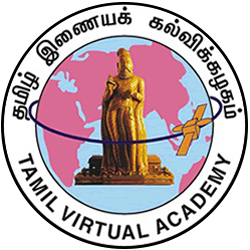Primary tabs
D03134 Principles of Poetry - ‘Vaidaruppam’-I
This lesson offers an insight into ‘Cheyyul Neri’ or the principles of poetry. ‘Dandialangaaram’, the ancient grammar text on figures of speech falls into 3 sections. The first section of this book called ‘Podhuvaniiyal’ deals with the different types of verses, the rules governing epic poetry and principles of poetry.
A description of the different types of ‘sol amaippu’ or word formation in verses is called ‘cheyyul neri’. There are 2 types of Cheyyul Neri. They are ‘Vaidaruppa Neri’ and ‘Gauda Neri’. The cheyyul neri expounded by the people of Vidarba is known as ‘Vaidaruppa Neri’. ‘Vaidaruppa Neri’ lays emphasis on simplicity and spontaneity. It is believed that ‘Kauda Neri’ was propounded by Kaudars who belonged to the country called ‘Gauda’. This cheyyul neri was intended to be a refutation of the ‘Vaidaruppa Neri’. Both ‘Vidaruppa Neri’ and ‘Gauda Neri’ are marked by 10 characteristic features. They are: ‘serivu’, ‘thelivu’, ‘samanilai’, ‘inbam’, ‘ozhugisai’, ‘udaaram’, ‘uythalil porunmai’, ‘kantham’, ‘vali’ and ‘samathi’. This lesson explains the first 5 characteristics of ‘Vaidauppa Neri’-viz, ‘serivu’, ‘thelivu’, ‘samanilai’, ‘inbam’ and ‘ozhugisai’ with suitable examples.
‘Serivu’ denotes the terse organization of sounds in a verse. ‘Serivu’ or terseness may be achieved through a rhythmic arrangement of the ‘vallina ottrugal’ - i.e., the six hard consonants of the Tamil tripartite system, or ‘vallina uyirmeigal’ i.e., - the vowel-consonants of ‘vallinam’ or ‘uyir nettezhuthukkal’ - i.e., long vowels and ‘uyirmei nettezhuthukkal’- i.e., long vowel consonants.
‘Thelivu’ signifies clarity or the technique of conveying the meaning without ambiguity. ‘Samanilai’ is balance. This refers to the art of balancing the ‘vallinam’, ‘mellinam’ and ‘idaiyinam’ sounds or the 3 sets of consonants in the Tamil tripartite system, in a verse.
‘Inbam’ denotes the joy that poetry gives its readers. There are 2 types of ‘inbam’ - ‘sol inbam’ and ‘porul inbam’. The use of ‘ethugai-monai’ i.e., (alliteration), ‘siledai’ i.e., (paronomasia), ‘madakku’ i.e., (pun), ‘muran’ i.e., (oxymoron) and ‘vandasolle varuthal’ i.e., (refrain) impart ‘sol inbam’ to poetry.
Vivid descriptions, imagination and striking comparisons or allusions account for the ‘porul inbam’ in poetry.
‘Ozhugisai’ refers to the mellifluousness or musical strength of poetry.


